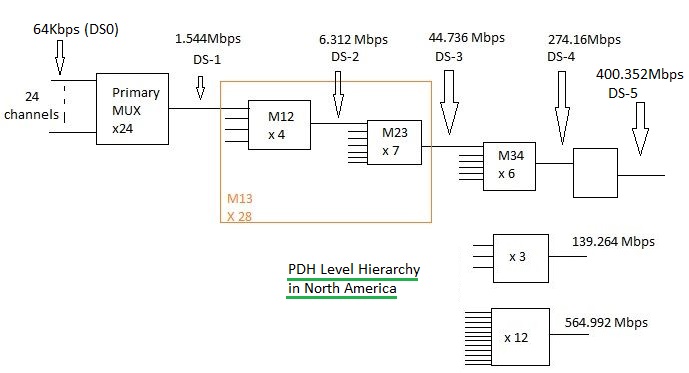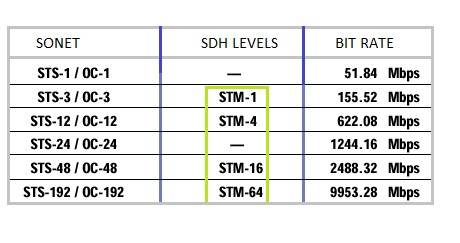PDH vs SDH | difference between PDH and SDH
Mục Lục
PDH vs SDH | Difference between PDH and SDH
This page PDH vs SDH describes difference between PDH and SDH.
It explains basics of PDH and SDH and mentions useful difference between terms.
PDH stands for Plesiochronous Digital Hierarchy and SDH stands for Synchronous Digital Hierarchy.
Both PDH and SDH are terminologies associated with digital multiplexers used in exchanges.
The different hierarchies having different bit rates are combined. These hierarchies will comprised of
many such bit streams/channels (either 24,30 or multiples) often called as tributaries.
PDH
In PDH, digital multiplexer’s inputs(bit streams) are of same bit rate
and are derived from different clocks from different oscillators.
Each will differ within tolerance of few clock periods. Hence it is called plesiochronous.
Bit Interleaving is used in PDH to combine digital signals.

In PDH there are two main standards i.e. 30 channel one used in Europe
and 24 channel one used in North America/Japan. Basic rate is 64 Kbps in North America(designated as DS0) and in Europe (designated as E0).
Rates derived from 2.048 Mbps basic rate including bit stuffing in 30 channel case are mentioned below.
2.048 x 4 gives 8.448 Mbps (120 channels)
8.448 x 4 gives 34.368 Mbps (480 channels)
34.368 x 4 gives 139.264 Mbps (1920 channels)
139.264 x 4 gives 564.992 Mbps (7680 channels)

The figure-1 depicts PDH level hierarchy used in North America while figure-2 depicts PDH levels used in Europe.
Rates derived from 1.544 Mbps basic rate including bit stuffing in 24 channel case are mentioned below.
1.544 x 4 gives 6.312 Mbps (96 channels)
6.312 x 7 gives 44.736 Mbps (672 channels)
44.736 x 6 gives 274.16 Mbps (4032 channels)
44.736 x 3 gives 139.264 Mbps
44.736 x 12 gives 564.992 Mbps
The table below mentions PDH rates used in Japan.
Level
data rate in Japan
0
0.064 Mbps
1
1.544 Mbps
2
6.312 Mbps
3
32.064 Mbps
4
97.928 Mbps
Following are the limitations of PDH:
• In PDH, different frame is used for transmission and in data layer.
Hence multiplexing and de-multiplexing is very complex.
• Accessing lower tributary requires the whole system to be de-multiplexed.
• The maximum capacity for PDH is 566 Mbps, which is limited in bandwidth.
• Tolerance is allowed in bit rates.
• PDH allows only Point-to-Point configuration.
• PDH does not support Hub.
• Every manufacturer has its own standards; PDH also has different multiplexing
hierarchies making it difficult to integrate interconnecting networks together.
SDH
As PDH was not scalable to support high capacity bandwidth and hence was not suitable to
accomodate growing traffic need. SONET was developed as American Standard while SDH as European
Standard.
SDH supports various topologies such as point to point,
ring, star, linear bus etc. It uses TDM and octet multiplexing.
It uses extremely precise timings. It employs both electrical and optical specifications.
In SDH, digital multiplexer’s inputs are of same bit rate and are derived from common clock, hence are in phase.
Hence it is synchronous.
Word(group of bits) Interleaving is used in SDH to combine digital signals.

SDH uses basic rate of 155.52 Mbps and four times multiples of this i.e. 622.08 Mbps and 2488.32Mbps.
Basic SDH rate of 155.52 is also known as STM-1. STM stands for Synchronous Transport Module.
SDH is referred as SONET (Synchronous Optical Network) in USA due to optical interfaces used.
Figure-3 depicts table mentioning SONET and SDH levels with their respective data rates.
As per CCITT, any of PDH rates upto 140 Mbps can be integrated with SDH rates up to 155.52 Mbps.
Following are the merits or advantages of SDH:
• A more simplified multiplexing and demultiplexing technique.
• Synchronous networking and SDH supports
multipoint networking.
• Capability of transporting existing PDH signals.
•
Easy growth to higher bit rates which enhances
the administration and maintenance process.
• It is capable of transporting broadband signals.
• It is multivendor and supports different operators.
• It provides network transport services on LAN
such as video conferencing, and interactive
multimedia.
• Optical fibre bandwidth can be increased without
limit in SDH.
•
Switching protection to traffic is offered by rings.
• SDH allows quick recovery from failure.
PDH vs SDH | Difference between PDH and SDH
Following table compares PDH vs SDH with respect to various parameters and mention difference between PDH and SDH
in the form of table below.
PDH
SDH
Plesiochronous Digital Hierarchy
Synchronous Digital Hierarchy
In PDH, reference clock is not synchronized throughout the network.
In SDH, Reference clock is synchronized throughout the network.
There is no synchronization between payload and frame.
There is synchronization between payload and frame.
PDH system has different frame structures at different hierarchy levels.
SDH system has consistent frame structures throughout the hierarchy.
Physical cross-connections are provided on the same level in PDH.
Digital cross-connections are provided at different signal levels in SDH.
In PDH, rates are derived from basic rate of 1.544 Mbps. The maximum capacity is about 566 Mbps.
In SDH, rates are derived from basic rate of 155.52 Mbps. The maximum up to 40 Gbps rates can be derived from basic rate
mentioned.
There is no universal standard for PDH.
Universal standard exists for SDH.
PDH is incompatible with other signals such as ATM, FDDI, DQDB etc.
SDH is compatible with other signals such as ATM, FDDI, DQDB etc.
Multipling method used in PDH is complex.
Multipling method used in SDH is simple.
Implementation cost of PDH is lower.
Implementation cost of SDH is higher.
PDH SDH RELATED LINKS
Enthusiasts of PDH and SDH can also refer following pages on PDH as well as SDH terminologies.
It covers difference between SONET vs SDH, SDH tutorial, PDH and SDH frame structure, SDH modulation, PDH over SONET and so on.
•SONET versus SDH
•What is PDMA?
•What is WDM?
•SONET SDH tutorial
•SDH Networks
•SDH Frame structure
•SDH Modulation
•PDH over SONET
•PDH Frame structure
What is Difference between
difference between FDM and OFDM
Difference between SC-FDMA and OFDM
Difference between SISO and MIMO
Difference between TDD and FDD
Difference between 802.11 standards viz.11-a,11-b,11-g and 11-n
OFDM vs OFDMA
CDMA vs GSM
Share this page
Translate this page















![Toni Kroos là ai? [ sự thật về tiểu sử đầy đủ Toni Kroos ]](https://evbn.org/wp-content/uploads/New-Project-6635-1671934592.jpg)


